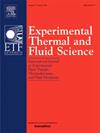Flow field analysis of submerged oblique and normally impinging twin jets at varying impinging angles
IF 3.3
2区 工程技术
Q2 ENGINEERING, MECHANICAL
Experimental Thermal and Fluid Science
Pub Date : 2025-04-11
DOI:10.1016/j.expthermflusci.2025.111491
引用次数: 0
Abstract
In this work, two-dimensional time-resolved particle image velocimetry (TR-PIV) measurements are carried out to study the flow structure and impinging interactions of two turbulent submerged isothermal circular impinging water jets. In this configuration, the uphill and downhill jets impinge obliquely and normally onto a flat target surface, respectively. A comprehensive parametric study is carried out for values of the jets’ exit Reynolds number of and 8000, jets’-to-surface target distances of and 5, and inclination angles of the uphill oblique jet-to-impingement surface of (30°, 45°, 60°). For all the experiments, the jet-to-jet spacing distances were varied for each impingement angle of the oblique jet so that the impingement point of both jets coincide at the geometric intersection of the jets’ axes. Flow visualization images showing ensemble-averaged and instantaneous flow distributions and turbulent characteristics for equal and non-equal Reynolds numbers of the jets are presented. Velocity profiles and Reynolds shear stress distributions of the downhill wall jet development and its corresponding dimensionless shedding frequencies are also obtained. A proper orthogonal decomposition (POD) analysis reveals the spatial structure of the dominant fluctuation motions of the turbulent flow as well as their respective contributions to the total kinetic energy. Our results show that the jets’ exit Reynolds numbers, the oblique impingement angle of the uphill jet and the jets’-to-surface distance play a major role on the complex flow structure and dynamics, location of the stagnation point and entrainment characteristics of the turbulent flow field of the twin jets.
不同撞击角度下浸没斜向和正常撞击双射流的流场分析
本文采用二维时间分辨粒子图像测速技术(TR-PIV)研究了两种湍流浸没等温圆形撞击水射流的流动结构和撞击相互作用。在这种配置中,上坡和下坡射流分别斜向和正常地撞击平坦的目标表面。对射流出口雷诺数Rej=5000和8000、射流与地面目标距离H/D=3和5、上坡斜射流与撞击面倾角(θ1=30°、45°、60°)进行了综合参数化研究。在所有实验中,斜射流的各个冲击角都改变了射流间距距离,使两种射流的冲击点重合在两种射流轴线的几何交点处。给出了射流在等雷诺数和非等雷诺数条件下的总体平均和瞬时流动分布以及湍流特性的流动可视化图像。得到了下坡壁面射流发展的速度分布、雷诺数剪应力分布及其相应的无因次脱落频率。适当的正交分解(POD)分析揭示了湍流主要波动运动的空间结构及其对总动能的贡献。结果表明,射流的出口雷诺数、上坡射流的斜冲击角和射流与表面的距离对双射流复杂的流动结构和动力学、滞止点位置和湍流流场的夹带特性起着重要作用。
本文章由计算机程序翻译,如有差异,请以英文原文为准。
求助全文
约1分钟内获得全文
求助全文
来源期刊

Experimental Thermal and Fluid Science
工程技术-工程:机械
CiteScore
6.70
自引率
3.10%
发文量
159
审稿时长
34 days
期刊介绍:
Experimental Thermal and Fluid Science provides a forum for research emphasizing experimental work that enhances fundamental understanding of heat transfer, thermodynamics, and fluid mechanics. In addition to the principal areas of research, the journal covers research results in related fields, including combined heat and mass transfer, flows with phase transition, micro- and nano-scale systems, multiphase flow, combustion, radiative transfer, porous media, cryogenics, turbulence, and novel experimental techniques.
 求助内容:
求助内容: 应助结果提醒方式:
应助结果提醒方式:


